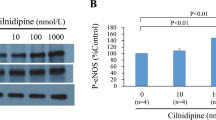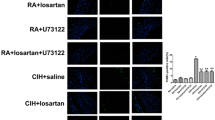Abstract
Our previous study demonstrated that norepinephrine (NE) induces endothelial apoptosis mainly through down-regulation of Bcl-2 protein and activation of the β-adrenergic and caspase-2 pathways. However, whether reactive oxygen species (ROS) and mitogen-activated protein kinases (MAPKs) are involved in this signal transduction remains unknown. Endothelial cells cultured from neonatal rat heart were treated with 100 μM NE. Proteins of MAPKs and Bcl-2 family were assayed by Western blotting. Apoptosis was determined by terminal deoxynucleotidyl transferase-mediated nick end-labeling assay. ROS was analyzed with flow cytometry. Caspase activity was measured using specific fluorogenic substrates. Treatment with NE increased intracellular ROS level and extracellular signal-regulated kinase (ERK), c-Jun N-terminal kinase (JNK), and p38 phosphorylation. Whereas the phosphorylated form of Akt was decreased. The NE-induced apoptosis was abrogated by SP600125 (a specific inhibitor of JNK). Antioxidants such as vitamin C and N-acetyl cysteine inhibited NE-induced ROS production, JNK phosphorylation, caspase activation and apoptosis. Exogenously added superoxide dismutase or catalase markedly diminished NE-induced ROS production and cell death. In conclusions, our study is the first report documenting that NE induces apoptosis in neonatal rat endothelial cells via a ROS-dependent JNK activation pathway. Antioxidants may be useful in the prevention and management of NE-mediated endothelial apoptosis during heart failure.
Similar content being viewed by others
References
Tavazzi L, Opasich C (1999) Clinical epidemiology of heart failure. Congest Heart Fail 5:260–269
Pepper GS, Lee RW (1999) Sympathetic activation in heart failure and its treatment with beta-blockade. Arch Intern Med 159:225–234
Katz SD (1997) Mechanisms and implications of endothelial dysfunction in congestive heart failure. Curr Opin Cardiol 12:259–264
Sharma R, Davidoff MN (2002) Oxidative stress and endothelial dysfunction in heart failure. Congest Heart Fail 8:165–172
Rossig L, Haendeler J, Mallat Z et al (2000) Congestive heart failure induces endothelial cell apoptosis: protective role of carvedilol. J Am Coll Cardiol 36:2081–2089
Lopez Farre A, Casado S (2001) Heart failure, redox alterations, and endothelial dysfunction. Hypertension 38:1400–1405
Fu YC, Chi CS, Yin SC, Hwang B, Chiu YT, Hsu SL (2004) Norepinephrine induces apoptosis in neonatal rat endothelial cells via down-regulation of Bcl-2 and activation of beta-adrenergic and caspase-2 pathways. Cardiovasc Res 61:143–151
Finkel T (2001) Reactive oxygen species and signal transduction. IUBMB Life 52:3–6
Simon HU, Haj-Yehia A, Levi-Schaffer F (2000) Role of reactive oxygen species (ROS) in apoptosis induction. Apoptosis 5:415–418
Sylte MJ, Inzana TJ, Czuprynski CJ (2004) Reactive oxygen and nitrogen intermediates contribute to Haemophilus somnus lipooligosaccharide-mediated apoptosis of bovine endothelial cells. Vet Immunol Immunopathol 97:207–217
Kotamraju S, Konorev EA, Joseph J, Kalyanaraman B (2000) Doxorubicin-induced apoptosis in endothelial cells and cardiomyocytes is ameliorated by nitrone spin traps and ebselen. Role of reactive oxygen and nitrogen species. J Biol Chem 275:33585–33592
Du X, Stocklauser-Farber K, Rosen P (1999) Generation of reactive oxygen intermediates, activation of NF-kappaB, and induction of apoptosis in human endothelial cells by glucose: role of nitric oxide synthase? Free Radic Biol Med 27:752–763
Rauen U, Polzar B, Stephan H, Mannherz HG, de Groot H (1999) Cold-induced apoptosis in cultured hepatocytes and liver endothelial cells: mediation by reactive oxygen species. FASEB J 13:155–168
Deshpande SS, Angkeow P, Huang J, Ozaki M, Irani K (2000) Rac1 inhibits TNF-alpha-induced endothelial cell apoptosis: dual regulation by reactive oxygen species. FASEB J 14:1705–1714
Dimmeler S, Zeiher AM (2000) Reactive oxygen species and vascular cell apoptosis in response to angiotensin II and pro-atherosclerotic factors. Regul Pept 90:19–25
Wada T, Penninger JM (2004) Mitogen-activated protein kinases in apoptosis regulation. Oncogene 23:2838–2849
Guyton KZ, Liu Y, Gorospe M, Xu Q, Holbrook NJ (1996) Activation of mitogen-activated protein kinase by H2O2. Role in cell survival following oxidant injury. J Biol Chem 271:4138–4142
Yoshizumi M, Tsuchiya K, Tamaki T (2001) Signal transduction of reactive oxygen species and mitogen-activated protein kinases in cardiovascular disease. J Med Invest 48:11–24
Ramachandiran S, Huang Q, Dong J, Lau SS, Monks TJ (2002) Mitogen-activated protein kinases contribute to reactive oxygen species-induced cell death in renal proximal tubule epithelial cells. Chem Res Toxicol 15:1635–1642
Dabrowski A, Boguslowicz C, Dabrowska M, Tribillo I, Gabryelewicz A (2000) Reactive oxygen species activate mitogen-activated protein kinases in pancreatic acinar cells. Pancreas 21:376–384
Kannan K, Jain SK (2000) Oxidative stress and apoptosis. Pathophysiology 7:153–163
Feuerstein GZ, Young PR (2000) Apoptosis in cardiac diseases: stress- and mitogen-activated signaling pathways. Cardiovasc Res 45:560–569
Remondino A, Kwon SH, Communal C et al (2003) Beta-adrenergic receptor-stimulated apoptosis in cardiac myocytes is mediated by reactive oxygen species/c-Jun NH2-terminal kinase-dependent activation of the mitochondrial pathway. Circ Res 92:136–138
Richards PS, Saba TM, Del Vecchio PJ, Vincent PA, Gray VC (1986) Matrix fibronectin disruption in association with altered endothelial cell adhesion induced by activated polymorphonuclear leukocytes. Exp Mol Pathol 45:1–21
Antin PB, Mar JH, Ordahl CP (1988) Single cell analysis of transfected gene expression in primary heart cultures containing multiple cell types. Biotechniques 6:640–649
Zhang X, Shan P, Sasidhar M et al (2003) Reactive oxygen species and extracellular signal-regulated kinase1/2 mitogen-activated protein kinase hyperoxia-induced cell death in lung epithelium. Am J Respir Cell Mol Biol 28:305–315
Rottenberg H, Wu S (1998) Quantitative assay by flow cytometry of the mitochondrial membrane potential in intact cells. Biochim Biophys Acta 1404:393–404
Isabelle M, Monteil C, Moritz F et al (2005) Role of a1-adrenoreceptors in cocaine-induced NADPH oxidase expression and cardiac dysfunction. Cardiovasc Res 67:699–704
Griendling KK, Sorescu D, Ushio-Fukai M (2000) NADPH oxidase: role in cardiovascular biology and disease. Circ Res 86:494–501
Rajagopalan S, Kurz S, Munzel T et al (1996) Angiotensin II-mediated hypertension in the rat increases vascular superoxide production via membrane NADH/NADPH oxidase activation: contribution to alterations of vasomotor tone. J Clin Invest 97:1916–1923
Mohazzab KM, Kaminski PM, Wolin MS (1994) NADH oxidoreductase is a major source of superoxide anion in bovine coronary artery endothelium. Am J Physiol 266:H2568–H2572
Babior BM (1999) NADPH oxidase: an update. Blood 93:1464–1476
Farre AL, Casado S (2001) Heart failure, redox alterations, and endothelial dysfunction. Hypertension 38:1400–1405
Fu YC, Chi CS, Yin SC, Hwang B, Chiu YT, Hsu SL (2004) Norepinephrine induces apoptosis in neonatal rat cardiomyocytes through a reactive oxygen species-TNFα-caspase signaling pathway. Cardiovasc Res 62:558–567
Qin F, Rounds NK, Mao W, Kawai K, Liang CS (2001) Antioxidant vitamins prevent cardiomyocyte apoptosis produced by norepinephrine infusion in ferrets. Cardiovasc Res 51:736–748
Bleeke T, Zhang H, Madamanchi N, Patterson C, Faber JE (2004) Catecholamine-induced vascular wall growth is dependent on generation of reactive oxygen species. Circ Res 94:37–45
Bindoli A, Rigobello MP, Deeble DJ (1992) Biochemical and toxicological properties of the oxidation products of catecholamines. Free Radical Boil Med 13:391–405
Aruoma OI, Halliwell B, Joey BM, Butler J (1989) The antioxidant action of N-acetylcysteine: its reaction with hydrogen peroxide, hydroxyl radical, superoxide, and hypochlorous acid. Free Radic Biol Med 6:593–597
Abello PA, Fidler SA, Buchman TG (1994) Thiol reducing agents modulate induced apoptosis in porcine endothelial cells. Shock 2:79–83
Galle J, Heermeier K, Wanner C (1999) Atherogenic lipoproteins, oxidative stress and cell death. Kidney Int Suppl 71:S62–S65
May JM (2000) How does ascorbic acid prevent endothelial dysfunction? Free Rad Biol Med 28:1421–1429
Yoshizumi M, Abe J, Haendeler J, Huang Q, Berk BC (2000) Src and Cas mediate JNK activation but not ERK1/2 and p38 kinases by reactive oxygen species. J Biol Chem 275:11706–11712
Aoki H, Kang PM, Hampe J et al (2002) Direct activation of mitochondrial apoptosis machinery by c Jun N-terminal kinase in adult cardiac myocytes. J Biol Chem 277:10244–10250
Qin F, Shite J, Liang C (2003) Antioxidants attenuate myocyte apoptosis and improve cardiac function in CHF: association with changes in MAPK pathways. Am J Physiol Heart Physiol 285:H822–H832
Dougherty CJ, Kubasiak LA, Prentice H, Andreka P, Bishopric NH, Webster KA (2002) Activation of c-Jun N-terminal kinase promotes survival of cardiac myocytes after oxidative stress. Biochem J 362:561–571
Xia Z, Dickens M, Raingeaud J, Davis R, Greenberg M (1995) Opposing effects of ERK and JNK-p38 MAP kinases on apoptosis. Science 270:1326–1331
Chen YR, Meyer CF, Tan TH (1996) Persistent activation of c-Jun N-terminal kinase 1 (JNK1) in gamma radiation-induced apoptosis. J Biol Chem 271:631–634
Luo Y, Umegaki H, Wang X, Abe R, Roth GS (1998) Dopamine induces apoptosis through an oxidation-involved SAPK/JNK activation pathway. J Biol Chem 273:3756–3764
Yang SE, Hsieh MT, Tsai TH, Hsu SL (2003) Effector mechanism of magnolol-induced apoptosis in human lung squamous carcinoma CH27 cells. British J Pharmacol 138:193–201
Shiojima I, Walsh K (2002) Role of Akt signaling in vascular homeostasis and angiogenesis. Circ Res 90:1243–1250
Nicholson KM, Anderson NG (2002) The protein kinase B/Akt signaling pathway in human malignancy. Cell Signalling 14:381–395
Martin D, Salinas M, Fujita N, Tsuruo T, Cuadrado A (2002) Ceramide and reactive oxygen species generated by H2O2 induce caspase-3-independent degradation of Akt/protein kinase B. J Biol Chem 277:42943–42952
Liang CS, Rounds NK, Dong E, Stevens SY, Shite J, Qin F (2000) Alterations by norepinephrine of cardiac sympathetic nerve terminal function and myocardial b-adrenergic receptor sensitivity in the ferret: normalization by antioxidant vitamins. Circulation 102:96–103
Author information
Authors and Affiliations
Corresponding author
Rights and permissions
About this article
Cite this article
Fu, YC., Yin, SC., Chi, CS. et al. Norepinephrine induces apoptosis in neonatal rat endothelial cells via a ROS-dependent JNK activation pathway. Apoptosis 11, 2053–2063 (2006). https://doi.org/10.1007/s10495-006-0192-8
Published:
Issue Date:
DOI: https://doi.org/10.1007/s10495-006-0192-8




